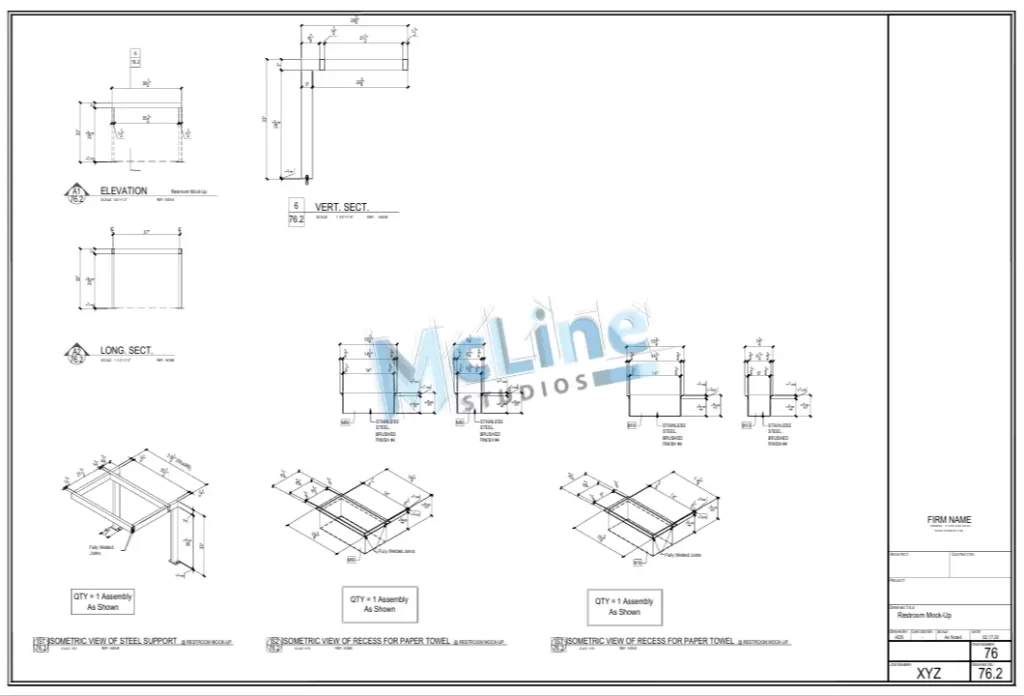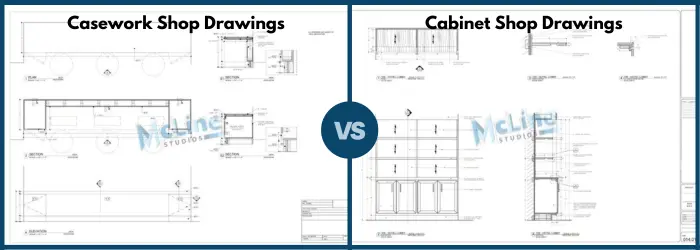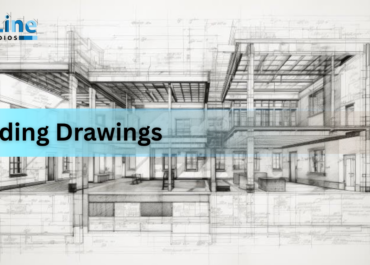In furniture manufacturing, the two terms cabinet shop drawings and casework shop drawings are often considered similar but these two serve distinct purposes and cater to different aspects of the furniture-making process.
The focus of cabinet shop drawings is on the detailed design and specifications of cabinets. They include information on dimensions, materials, joinery, and hardware placement. This makes sure each cabinet is built according to the designer’s vision and functional requirements.
However, casework shop drawings contain a broader range of built-in furniture elements, such as shelves, desks, and custom storage units. These drawings not only detail the construction of each piece but also illustrate how they integrate into the overall design of the space.
This article will explore the differences between these two in detail. Today, we’ll understand what makes the difference between cabinet and casework shop drawings. So, let’s start.
What Are Cabinet Shop Drawings?
Cabinet shop drawings are detailed illustrations and plans used in the cabinet-making industry to guide the construction and installation of cabinets. These drawings provide all the necessary information for fabricating and assembling cabinets according to specific design requirements.

The purpose of cabinet shop drawings is to provide detailed plans for constructing and installing cabinets, including precise dimensions, materials, and assembly instructions. They serve as a communication tool between designers, manufacturers, and installers.
These drawings help visualize the final product, estimate costs, and guide installation, minimizing errors and ensuring the cabinets meet design specifications.
What Are Casework Shop Drawings?
Casework shop drawings are detailed technical drawings created to guide the construction and installation of built-in fixtures, such as cabinets, countertops, and shelving units. They provide detailed specifications for diverse elements in a space, often integrating with architectural features and other systems.
Casework shop drawings are fundamental for the successful creation and installation of cabinetry and related fixtures. Whereas cabinet shop drawings are solely focused on the manufacturing and installation of a cabinet.
Cabinet Shop Drawings vs. Casework Shop Drawings
Here is the detailed differentiation between cabinet shop drawings and casework shop drawings:
| Aspect | Cabinet Shop Drawings | Casework Shop Drawings |
| Scope | Generally focuses on standalone cabinets or modular cabinet systems. | Broader scope that includes integrated built-in systems, often incorporating cabinetry, shelving, and custom features. |
| Detail Level | Often focuses on specific cabinet components, like door and drawer configurations. | Includes detailed plans for entire systems, showing how various casework elements integrate. |
| Components | Mainly concerned with individual cabinet parts, hardware placement, and finishes. | Includes all components of the casework system, including the layout, connections, and structural elements. |
| Design Focus | Focuses on cabinet design, dimensions, and aesthetics. | Focuses on the overall casework layout, including integration with other building elements and structural considerations. |
| Use Cases | Used for designing kitchen cabinets, bathroom vanities, and standalone storage units. | Used for designing built-in features like bookshelves, integrated workstations, or complete wall units. |
| Construction Details | Focuses on cabinet joinery, panel thickness, and door hardware. | Focuses on how casework integrates with walls, ceilings, and floors, and may include structural details. |
| Drawing Types | Includes elevations, sections, and detailed component views of individual cabinets. | Includes floor plans, elevations, and sections, and often includes coordination with other building systems. |
| End Use | Primarily used by cabinetmakers and installers for constructing individual cabinets. | Majorly used by contractors and builders for installing custom casework systems. |
| Integrations | Not focused on the integration with others, mainly focused on cabinetry itself. | Often includes details on how the casework interacts with electrical, plumbing, and other building systems. |
What To Choose?: Cabinet Shop Drawings Or Casework Shop Drawings
The choice between cabinet shop drawings and casework shop drawings often depends on the specifics of the project:

- Project Scope: If the project focuses solely on cabinetry, such as kitchen or bathroom cabinets, cabinet shop drawings might be more suitable. For larger projects involving a variety of built-in furniture elements, casework shop drawings might be the better choice.
- Detail Level: For highly detailed cabinet designs, cabinet shop drawings provide the necessary precision. Casework shop drawings offer a broader overview that can be useful for projects requiring a range of built-in solutions.
- Customization: Custom cabinetry projects benefit from the specific details provided in cabinet shop drawings. Conversely, casework shop drawings can handle both custom and standard designs, making them versatile for varied projects.
To make it easy, if you’re working on custom cabinetry projects and high details with specific features are required then opt for cabinet shop drawings.
If you’re working on integrated furniture projects with complex installation and standardized designs, go with casework shop drawings. It is also advisable to consult experts before undertaking any of these.
The Final Words
To sum it up, while both cabinet shop drawings and casework shop drawings serve the essential purpose of guiding construction and assembly, they cater to different aspects of woodworking projects.
Cabinet shop drawings are typically focused on individual cabinetry units, detailing dimensions, materials, and assembly instructions for standalone pieces such as kitchen cabinets or bathroom vanities.
They provide a detailed view of each cabinet’s structure, hardware placements, and finishing requirements, making them crucial for precise, standalone installations.
In contrast, casework shop drawings are broader in scope, designed for larger, more complex projects that often include multiple cabinetry units integrated into a cohesive system, such as built-in office furniture or custom closets.




